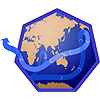|
Class Time Required |
1 class period |
|
|
| About 1 hour to read story and materials and make a reference map. |
|
|
Prior Student Knowledge |
Basic understanding of how to use a map to locate place names. Understanding of latitude and longitude. Use of an atlas is helpful. |
|
Vocabulary |
Derelict, flotsam and jetsam, gyre, rupture |
| Science GLEs Addressed |
6th Grade: SA1.1, SE2.2 7th Grade: SA1.1, SE2.2 8th Grade: SA1.1 |
 Overview: This is an introductory investigation to be done in one class period. Students read a true story about bath toys that fell off a container ship and washed up on beaches around the world. Using a world map, they identify, locate, and record the dates and places where the toys were found. Finally, they write a hypothesis about how the rubber toys made their way to the various locations identified.
Overview: This is an introductory investigation to be done in one class period. Students read a true story about bath toys that fell off a container ship and washed up on beaches around the world. Using a world map, they identify, locate, and record the dates and places where the toys were found. Finally, they write a hypothesis about how the rubber toys made their way to the various locations identified.


 Overview: In this 5-day investigation, students develop an understanding that the large ocean circulations affecting Alaska mimic major weather patterns. They begin by creating and observing wave and riffle patterns and motions of objects in a tub. They plot possible current patterns on their map and organize meteorological data to determine how well wind patterns match their predictions. After a lecture/discussion to learn more about currents and weather patterns, they role-play shipping captains who must consider wind and current patterns to find the quickest route from Seattle to Anchorage. They finish up with a discussion that takes them back to the question about the toys’ movements.
Overview: In this 5-day investigation, students develop an understanding that the large ocean circulations affecting Alaska mimic major weather patterns. They begin by creating and observing wave and riffle patterns and motions of objects in a tub. They plot possible current patterns on their map and organize meteorological data to determine how well wind patterns match their predictions. After a lecture/discussion to learn more about currents and weather patterns, they role-play shipping captains who must consider wind and current patterns to find the quickest route from Seattle to Anchorage. They finish up with a discussion that takes them back to the question about the toys’ movements. Overview: In this 7-10 day investigation, students develop an understanding of waves and tides and their motion through discussion, demonstration, and hands-on investigation. They demonstrate wave motion in containers, and create marigrams to show local tide data and to compare tide patterns from different parts of the world. They use their knowledge to consider whether waves or tides could account for the movement of the bath toys to their final locations.
Overview: In this 7-10 day investigation, students develop an understanding of waves and tides and their motion through discussion, demonstration, and hands-on investigation. They demonstrate wave motion in containers, and create marigrams to show local tide data and to compare tide patterns from different parts of the world. They use their knowledge to consider whether waves or tides could account for the movement of the bath toys to their final locations.
 Overview: In this 3-4 day investigation, students will develop an understanding of the two basic ways seafloor topography influences ocean circulation patterns, steering ocean flows and providing barriers to deep water mixing. They will draw and then construct a seafloor model and experiment with solutions of colored saline water to see how they behave when encountering underwater barriers. Students solidify their understanding through follow-up discussions and writing, and apply their understanding as they view an animated video clip illustrating interactions of ocean currents and climate.
Overview: In this 3-4 day investigation, students will develop an understanding of the two basic ways seafloor topography influences ocean circulation patterns, steering ocean flows and providing barriers to deep water mixing. They will draw and then construct a seafloor model and experiment with solutions of colored saline water to see how they behave when encountering underwater barriers. Students solidify their understanding through follow-up discussions and writing, and apply their understanding as they view an animated video clip illustrating interactions of ocean currents and climate.  Overview: Students take a field trip to investigate some of the phenomena that they have been studying. They inventory debris along a shoreline or riverbank and study local water movement patterns to develop ideas about where the debris might have come from. (In locations where this is not feasible students may look at other patterns of change in the local aquatic environment involving freezing and thawing, wind, rain, and/or tides.)
Overview: Students take a field trip to investigate some of the phenomena that they have been studying. They inventory debris along a shoreline or riverbank and study local water movement patterns to develop ideas about where the debris might have come from. (In locations where this is not feasible students may look at other patterns of change in the local aquatic environment involving freezing and thawing, wind, rain, and/or tides.)
 Overview: In this 5-12 day investigation students discuss and synthesize all of their experiences in the unit. With the help of an animation and a video, they develop a basic understanding of the global thermohaline “conveyor belt.” In small groups, they choose, complete, and present one of the following culminating projects:
Overview: In this 5-12 day investigation students discuss and synthesize all of their experiences in the unit. With the help of an animation and a video, they develop a basic understanding of the global thermohaline “conveyor belt.” In small groups, they choose, complete, and present one of the following culminating projects:





